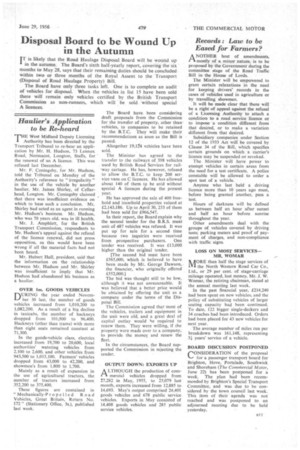Disposal Board to be Wound Up in the Autumn
Page 45

If you've noticed an error in this article please click here to report it so we can fix it.
IT is likely that the Road Haulage Disposal Board will be wound up I in the autumn. The Board's sixth half-yearly report, covering the six months to, May 28, says that their remaining duties should be concluded within two or three months of the Royal Assent to the Transport (Disposal of Road Haulage Property) Bill.
The Board have only three tasks left. One is to complete an audit of vehicles for disposal. When the vehicles in list 15 have been sold there will remain only vehicles certified by the British Transport Commission as non-runners, which will be sold without special A licences.
The Board have been considering draft proposals from the Commission for the transfer of property, other than vehicles, to companies to be retained by the R.T.C. They will make their recommendations as soon as the Bill is passed.
Altogether 19,114 vehicles have been sold.
The Minister has agreed to the transfer to the railways of 398 vehicles used by British Road Services for rail'way cartage. He has, however, refused to allow the B.T.C. to keep 200 service vans on C licences. He has allowed about 140 of them t9 be sold without special A licences during the present year.
He has approved the sale of 400 freehold and leasehold properties valued at £2,143,186. Up to April 30, 253 of them had been sold for £966,547.
In their report, the Board explain why the second tender for the B.R.S. meat unit of 487 vehicles was refused. It was put up. for sale for a second time because two inquiries were received from prospective purchasers. One tender was received. it was 113,000 higher than the original tender.
[The second bid must have been £565,000, which is believed to have been made by Mr. George Dawson,. the financier, who originally offered £552,000.1 The bid was .thought still to be low, although it was not unreasonable. It was believed that a better price would be obtained by offering the unit as a company under the terms of the Disposal Bill. The Commission agreed that most of the vehicles, trailers and equipment in the unit were old, and a great deal of capital outlay would he required to renew them. They were willing, if the property were made over to a company, to provide the money and renew the fleet.
In the circumstances, the Board supported the Commission in rejecting the tender.
















































































































































